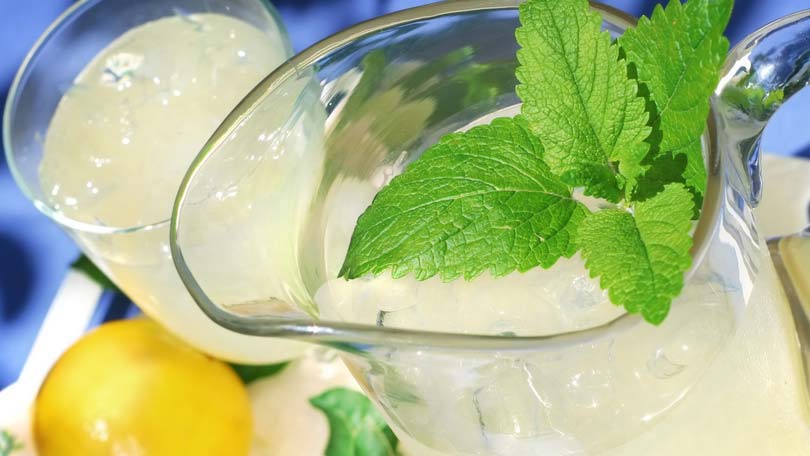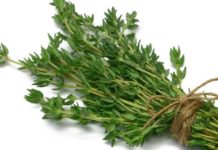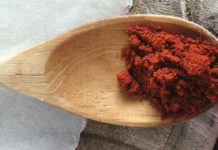
Mint, a plant which is part of the Mentha genus and a close relative of basil and rosemary, belongs to a large family of herbs with hundreds of varieties. For the purposes of this culinary discussion we will be focusing on the “true mints”, spearmint and peppermint, which are native to Europe and Asia. Mint’s refreshing, sweet, and cooling qualities makes it a divine and versatile herb which can be used in most cuisines with ease.
Characteristics
Mint is an aromatic perennial herb with vertical branches and stems. It grows no more than a few feet high and has long, narrow, vertical stems with alternating braches of leaves. The leaves, which are textured lanceolates with jagged edges, are pale to medium dark-green in color. The plant bears clustered, erect, pale purple or lilac colored flowers and tiny fruit with a few seeds inside, but the leaves are the only component frequently used in the kitchen. Mint grows easily and prefers plenty of water – it can grow in many climates, but easily dominates home gardens and must be monitored.
Mint has a very pleasing and fresh flavor with a sweet undertone and a cooling aftertaste. The scent is also distinctively refreshing and has been used frequently in the medical, aromatherapy, and cosmetics industries.
Common Uses
The herb’s name is derived from an ancient Greek myth, the story of the nymph Minthe. The legend claims the beautiful nymph was pursued by the god Pluto. His jealous wife couldn’t bear her lover’s infidelity, and Minthe was turned into a mint plant by the tale’s end. Mint therefore had mysterious and superstitious attachments for several thousand years; young Greek girls were known to weave mint leaves into their bridal wreaths as a symbol and of love and respect for the nymph and her plight.
Mint is a common herb used in Mediterranean, Indian, and Southeast Asian food. Both the leaves and essential oils play roles in the kitchen; fresh leaves are used to flavor meat dishes, grain based sides and salads like tabbouleh, yogurt, sauces, dips, soups, stews, candies, ice cream, teas, beverages, chewing gum, jellies, syrups, and even liquor (crème de menthe). They are also chopped and added to greens or fruit salads, Indian pulses, Turkish dolmas, Vietnamese summer rolls, or to various dishes as a garnish. Mint is wonderful with vegetables like garden peas, carrots, corn, sugar snap peas, or eggplant, and pairs even better with fruits such as pineapple, mango, papaya, strawberries, raspberries, and melon; is also works in sweet dishes when paired with chocolate or vanilla. The essential oil is a main flavoring agent for toothpastes, mouthwashes, breath mints, and some medications with an unpleasant flavor or aftertaste.
Medicinally speaking, the leaves have been used in several ways: as an insect repellent, a cure for hiccups, a mild stimulant, and as a known remedy for stomach ache, indigestion, and heartburn. Mint can also be brewed into tea for use as a diuretic. The menthol found in mint is soothing to the throat and can help with chest pain and coughing; for this reason it is sometimes added to cigarettes to mask tobacco’s flavor and the smoke’s irritating effect on the throat. The herb’s scent was also used in early forms of aromatherapy as it was said to refresh the mind.
Use and Storage
Fresh and dried mints are both available in the produce or spice aisles at most supermarkets and grocery stores. Fresh is considered far better for cooking, as its flavors are more distinguishable and pleasant on the palate. Fresh mint can be stored in the fridge for up to 48 hours before it begins to deteriorate. Dried mint should be kept in an airtight container out of direct sunlight.
Use It:
- in grain dishes like tabbouleh or pilafs
- in herb omelets or with eggs
- paired with chocolate or vanilla for special desserts
- with fruits like berries, papaya, pineapple, mango, or melon
- with veggies such as peas, carrots, potatoes, or snap peas
- added to jellies or sauces for lamb, red meats, or grilled chicken
- to season yogurt or sour cream based dips
- chopped and added to greens and/or fruit salads
- in beverages like tea
- in alcoholic drinks for a refreshing kick
- to flavor ice cream or frostings
- to freshen breath
Recipe using Mint
Mint Julep
5 sprigs fresh mint
1-1 ½ teaspoons sugar
2 oz. bourbon
2 tablespoons cool water
Plenty of crushed ice
In a tall glass put leaves, sugar, and water. Muddle the leaves, then stir until sugar is mostly dissolved. Add bourbon. Fill glass with ice. Gently stir until all ingredients are combined.
Raspberry Mint Sangria
½ cup fresh raspberries
½ fresh orange, diced
6-7 sprigs fresh mint
3 oz. brandy
1 ½ oz. Chambord or raspberry liqueur
1 bottle dry red wine
½ cup orange juice
½ cup pineapple juice
Splash ginger ale
In the bottom of a tall pitcher muddle 5 springs mint, orange juice, pineapple juice, and raspberries. Add liquors, ginger ale, and wine. Taste and adjust intensity – dilute with more juice or make stronger by adding more wine. Pour over plenty of ice into punch bowl or large pitcher. Add orange pieces and garnish with remaining whole springs of mint.




